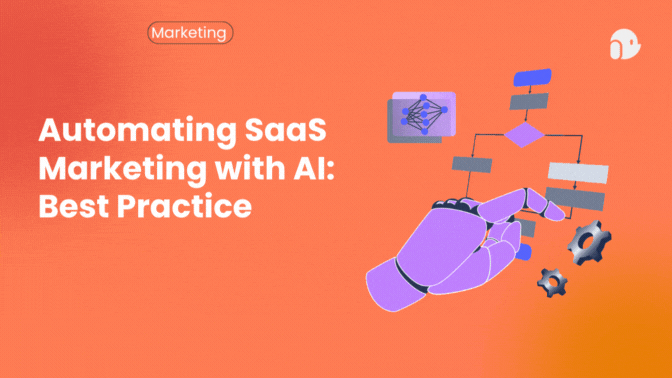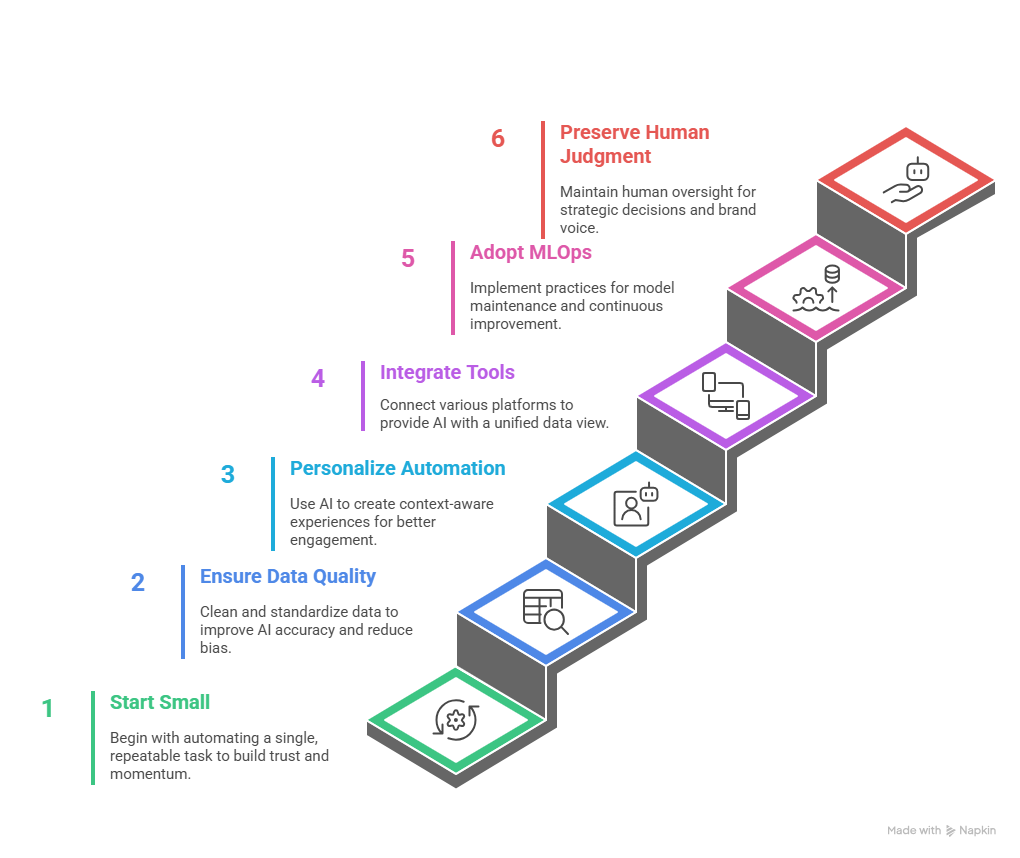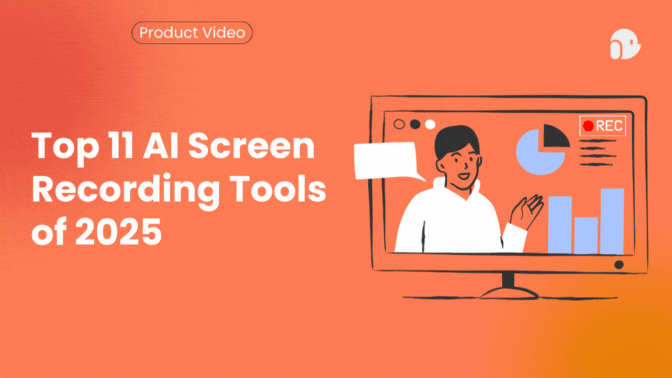Automating SaaS Marketing with AI: Best Practice

Let’s be honest: SaaS marketers are drowning in dashboards, emails, ad platforms, and one-off campaigns. You know the scene, half your week disappears into spreadsheets while the real strategy gets shoved to the weekend. AI changes that. It doesn’t just speed things up; properly applied, AI turns messy workflows into predictable, repeatable engines of growth. In this post, we’ll walk through practical best practices for automating SaaS marketing with AI. What to start with, what to avoid, and how to keep humans in the loop.
The problem: manual complexity, scaled expectations
SaaS buyers expect personalized journeys. They want relevant content, timely demos, and a product that feels designed for them. Delivering that at scale with humans alone? Painful and expensive. Manual processes mean slow response times, inconsistent personalization, and missed opportunities. That’s where AI-driven marketing automation becomes essential.
To better understand how AI enhances customer engagement through product experiences, you might want to check out this guide on leveraging AI product demos in marketing strategies. It dives deeper into how AI-powered demos can create more personalized and effective marketing touchpoints.
How AI actually improves SaaS marketing
AI isn’t magic; it’s pattern recognition on steroids. Combined with clean data, machine learning models can:
- Predict which leads will convert (predictive lead scoring).
- Personalize content and demo experiences automatically.
- Optimize ad spend and budget pacing.
- Identify churn risk and trigger proactive outreach.
The practical result: teams work smarter, not harder. You get better targeting, faster experiments, and measurable uplift in conversion and retention.
For SaaS marketers wondering how to balance automation with authenticity, this article on the AI content debate explains how to maintain content quality while scaling with automation.
Best practices: actionable steps to start today

1. Start small: pick one workflow to automate
Don’t try to overhaul everything at once. Choose a repeatable, high-volume task, email follow-ups, ad budget pacing, or demo personalization, and automate that first. Quick wins build trust and make it easier to expand.
2. Make data quality non-negotiable
AI is only as good as the data it learns from. Audit your CRM, standardize event names, and remove duplicates. If your customer profiles are messy, predictions will be noisy. Clean data gives you faster wins and reduces bias.
3. Focus on personalization over blanket automation
Automation without personalization is just faster noise. Use AI to deliver context-aware experiences: personalized demo videos, tailored CTAs, and dynamic landing pages. Tools like puppydog.io can auto-generate demo videos from screenshots, a smart way to personalize outreach at scale without burning hours.
4. Integrate tools and build an observability loop
Connect CRM, marketing automation, ad platforms, and analytics so the AI has a unified data view. Then measure everything: open rates, demo watches, MQL-to-SQL conversion, and churn signals. Continuous measurement lets you tune models and preserve ROI.
5. Adopt MLOps practices early
Models need maintenance. Set up versioning, CI/CD for model deployment, and automated testing. Even simple monitoring, tracking drift, and prediction accuracy, prevent surprises when market behavior changes.
6. Preserve human judgment
Let AI handle repetitive scoring and content generation, but keep humans in decision-making loops for brand voice, complex negotiations, and strategic bets. AI should amplify creativity, not replace it.
Real-world example: personalized demo outreach (mini case)
Imagine a small SaaS with a two-person sales team. Before AI, they recorded one generic demo and mailed it to prospects. Response rates ranged from 6% to 8%. After integrating personalized demo videos and predictive lead scoring, the team sent targeted demos that referenced each prospect’s use case. Engagement doubled, and leads who watched personalized demos were three times more likely to request a trial.
This is the kind of practical uplift that AI automation delivers when combined with clean data and a focused pilot.
Common mistakes to avoid
- Automating everything too fast. Start with low-risk pilots.
- Ignoring bias and compliance. Audit models for fairness and ensure GDPR/CCPA compliance.
- Treating AI as ‘set and forget’. Continuously retrain models and review outcomes.
Pro tips from practitioners
- Retrain models on recent data quarterly (or more often in fast-moving markets).
- Use human review for the first 1,000 AI-generated pieces of content to ensure voice consistency.
- Create a ‘fallback’ manual path if AI confidence scores are low.
Conclusion: a hybrid future
AI is not a replacement for marketers; it’s a multiplier. When you pair disciplined data practices with focused pilots and ethical governance, automation frees teams to spend time on the work that actually moves the business: storytelling, strategy, and relationship building. Start small, measure rigorously, and scale what works.
Ready to try personalized demos without the production fuss? Explore puppydog.io to create AI-assisted demo videos that feel handcrafted, minus the manual work.
FAQs
Q: Is AI marketing only for enterprise SaaS?
No. Small and mid-market SaaS companies can benefit, especially when they start with low-cost pilots and scale gradually.
Q: What’s the best first automation to implement?
Begin with repetitive, measurable processes: email segmentation, demo follow-ups, or ad budget pacing.
Q: How much should we invest in data cleanup?
Treat data cleanup as the top priority. Even modest investments can dramatically improve model performance and ROI.
Q: Will automation ruin our brand voice?
Not if you include human review and guardrails. Use AI for drafts and patterns; humans should finalize customer-facing messages.
Q: How do we handle privacy and compliance?
Use consent-driven data practices, anonymize when possible, and maintain transparency about how customer data is used.
Further Reading
Looking to dive deeper into AI-powered SaaS marketing? Here are some trusted, non‑competitor resources to expand your knowledge:
- AI Will Shape the Future of Marketing — A Harvard Professional Education piece exploring how marketers can prepare for AI‑driven transformations across analytics, content, and automation.
- Predictive Lead Scoring + AI Is a Game Changer — Salesforce explains how predictive lead scoring powered by AI can elevate your sales and marketing alignment.
- AI Marketing Automation: What, Where, and How? — A peer‑reviewed study on the applications, opportunities, and challenges of AI‑driven marketing automation.

Sarah Thompson is a storyteller at heart and Business Developer at PuppyDog.io. She’s passionate about creating meaningful content that connects people with ideas, especially where technology and creativity meet.






